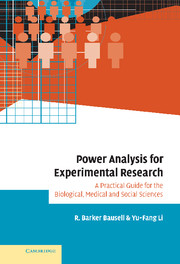 Power Analysis for Experimental Research
Power Analysis for Experimental Research Book contents
- Frontmatter
- Contents
- Introduction
- 1 The conceptual underpinnings of statistical power
- 2 Strategies for increasing statistical power
- 3 General guidelines for conducting a power analysis
- 4 The t-test for independent samples
- 5 The paired t-test
- 6 One-way between subjects analysis of variance
- 7 One-way between subjects analysis of covariance
- 8 One-way repeated measures analysis of variance
- 9 Interaction effects for factorial analysis of variance
- 10 Power analysis for more complex designs
- 11 Other power analytic issues and resources for addressing them
- Technical appendix
- Bibliography
- Index
5 - The paired t-test
Published online by Cambridge University Press: 28 August 2009
- Frontmatter
- Contents
- Introduction
- 1 The conceptual underpinnings of statistical power
- 2 Strategies for increasing statistical power
- 3 General guidelines for conducting a power analysis
- 4 The t-test for independent samples
- 5 The paired t-test
- 6 One-way between subjects analysis of variance
- 7 One-way between subjects analysis of covariance
- 8 One-way repeated measures analysis of variance
- 9 Interaction effects for factorial analysis of variance
- 10 Power analysis for more complex designs
- 11 Other power analytic issues and resources for addressing them
- Technical appendix
- Bibliography
- Index
Summary
Purpose of the statistic
The paired t-test (also called the correlated t-test and the t-test for dependent means) is used to ascertain how likely the difference between two means that contain the same (or matched) observations is to occur by chance alone. These means may represent pretest–posttest differences involving the same group of subjects, posttest differences when subjects are randomly assigned to two groups in pairs based upon a pre-existing variable (or a pretest), or differences between two scores available on the same group of subjects in non-experimental research.
The paired t-test, then, is used when:
there are two continuous sets of numbers, and
the hypothesis to be tested is expressed in terms of a mean difference between these two sets of numbers.
The paired t-test is not used when:
the hypothesis to be tested is expressed in terms of whether or not these two sets of continuous numbers are related to one another,
there are more than two continuous sets of numbers (e.g., when there are pretest and posttest scores available on two or more groups),
there is another independent variable of interest besides the contrast between paired observations (e.g., it is desired to contrast a single group of subjects in a second manner, such as males vs. females), or
the two sets of continuous numbers are independent of one another (i.e., are not generated from the same group of subjects or matched pairs of subjects).
- Type
- Chapter
- Information
- Power Analysis for Experimental ResearchA Practical Guide for the Biological, Medical and Social Sciences, pp. 57 - 70Publisher: Cambridge University PressPrint publication year: 2002


